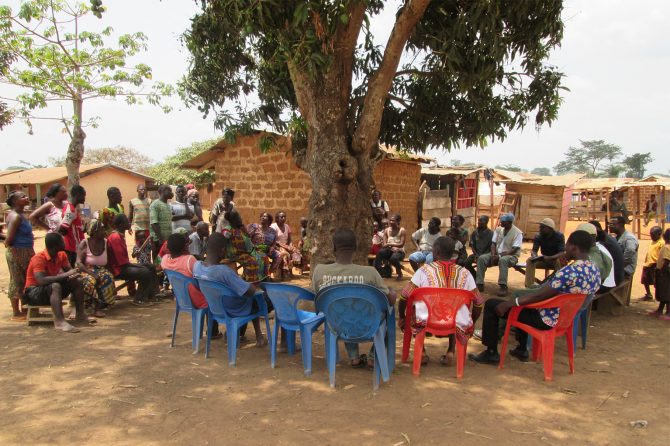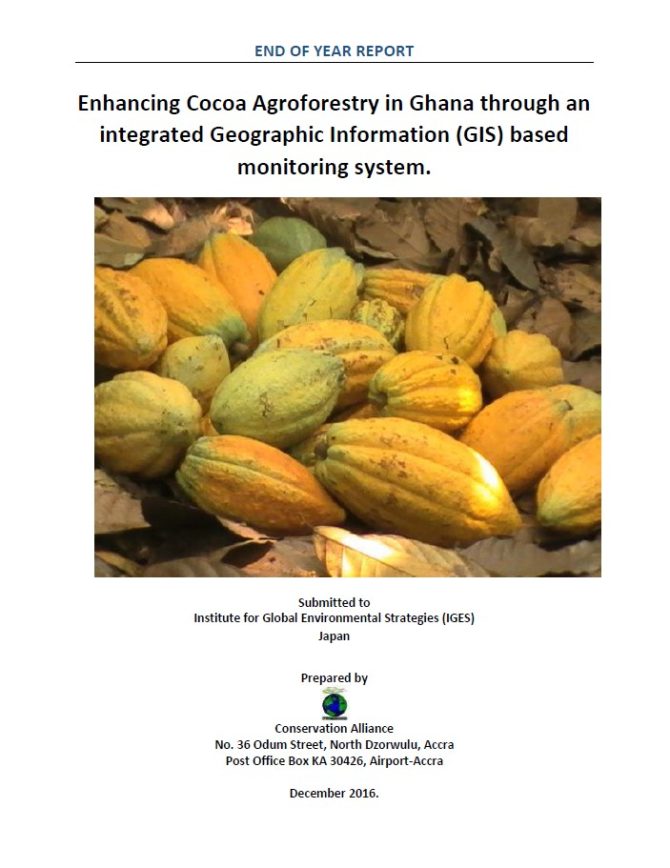2015 GHANA
Enhancing Cocoa Agroforestry in Ghana through an integrated Geographic Information System (GIS) based monitoring system
Conservation Alliance International
Community / field-based implementation
Landscape
Overview
The project area has rich biodiversity resources, which support cocoa cultivation. However, the majority of cocoa producers within the landscape have low household incomes due to low farm productivity. The project aimed to improve the productivity of target cocoa farmers by introducing good agricultural practices, and to mainstream biodiversity conservation into cocoa production landscapes around Kakum National Park (KNP) in the Central Region of Ghana.
Key achievements
- The project trained 40 lead farmers on good agricultural practices and other technical assistance, including integrated pest management, fertilizer application and record keeping. The lead farmers then trained 246 farmers, especially women and youth farmers, helping them to increase productivity of their farms. The average yield increased from an average 3 bags of cocoa per acre at the start of the project, to between 5-7 bags per acre by its end.
- Over 200 farmers became aware of biodiversity conservation through the establishment of tree nurseries in 20 beneficiary communities, which helped to increase tree cover on farms and degraded areas fringing the KNP.
- More than 80% of target farms are ready to undergo auditing for Rainforest Alliance Certification. Securing certification connotes improvement in the ecological health of the farms and qualifies the farmers to sell their cocoa beans as ‘certified cocoa’. Twenty farms were mapped with the use of GIS technology.
Lessons
- The activities under this project should be up-scaled to increase the number of beneficiaries in order to intensify productivity, reduce farm expansion and promote biodiversity conservation in the landscape.
- Initiatives within protected areas should incorporate traditional systems of biodiversity management into agricultural production landscapes.
- Traditional sites such as sacred groves located within agricultural landscapes should receive protected area status.
Project location
Organisation

Conservation Alliance International
- Sector
- Non-governmental organisation
- Country
- Ghana
- Website/SNS
- https://conservealliance.org/
Related products
End of Year Report: Enhancing Cocoa Agroforestry in Ghana through an integrated Geographic Information (GIS) based monitoring system
- Publisher
- Conservation Alliance International
In 2016, Conservation Alliance (CA), Cocoa Research Institute of Ghana (CRIB) and Rural Support Network (RSN) with funding from the Institute for Global Environmental Strategies (IGES) through the Satoyama Development Mechanism (SDM) implemented an integrated package program for cocoa farmers within the Kakum Conservation Area (KCA). The package included training farmers on good agricultural practices, farm management practices & capacity building on biodiversity conservation, community based monitoring and mapping systems. This report presents the objectives, activities, outcomes and recommendations of the project.
Relevant projects
Projects of the same year
Aichi Biodiversity Targets
Aichi Biodiversity Targets
-
Awareness increased
-
Biodiversity values integrated
-
Habitat loss halved or reduced
-
Sustainable agriculture, aquaculture and forestry
-
Knowledge improved, shared and applied
Sustainable Development Goals
Sustainable Development Goals
-
Zero hunger
-
Life on land


